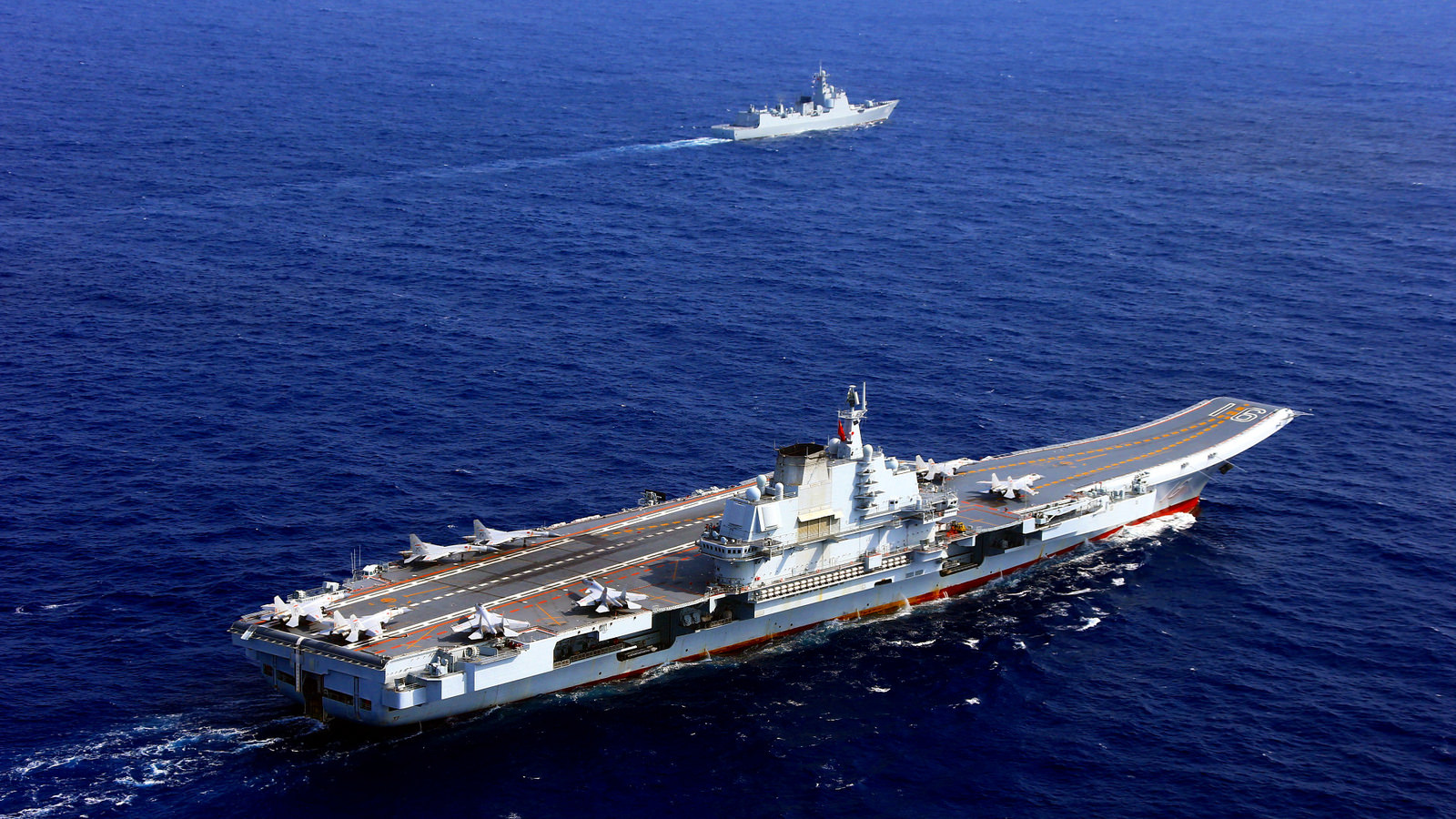The Impact of China's Military Expansion on Taiwan's Defense and Regional Security

After the PLA purchased the Liaoning, a military attack can be initiated from the east side of Taiwan. Our military force will lose the strategic depth of its battlefield, which is significant for Taiwan’s defensive operation. Source: rhk111, flickr, https://www.flickr.com/photos/rhk111/42032620622/in/album-72157668916125898/
Newsletter 2018 No. 13
The Impact of China's Military Expansion
on Taiwan's Defense and Regional Security
Dr. Cheng-kun Ma
Professor and Director,
Graduate Institute of China Military Affairs Studies,
Fu Hsing Kang College,
National Defense University
June 28, 2018
China's military modernization and the following military expansion have been very rapid in recent years. During the last decade, the PLA has expanded its activities from the offshore maritime area between the mainland coast and the First Island Chain to an area of the West Pacific between the First and the Second Island Chains. These activities reflect the growth of the PLA projection capability, and simultaneously create great military pressure on Taiwan and other regional countries.
The countries of East Asia, including Taiwan, have gotten used to the existing order and security status of this region which has been established by the United States since the end of WWII and the Korean War. This power balance between the democratic camp and the communist camp has been maintained for over 6 decades even though the cold war power structure collapsed during the 1990s. The confrontation between these two camps was, in the other words, a competition between a land power and a maritime power. The frontline of this confrontation was the waters between the Asian continent and the First Island Chain.
The contemporary rise of China began in the 1990s. Accompanying China's tremendous economic growth is the rapid modernization of the PLA. Before China’s military modernization, the PLA was a mainly army-centric troop with huge numbers of soldiers. Its airforce fighters could not fly outside its offshore areas, nor could its naval ships sail far from offshore maritime waters. Thus, the waters between the mainland and the First Island Chain were basically under the control of the democratic camp allies, mainly countries of the First Island Chain. Taiwan's airforce and navy had total control over the air and maritime space of the Taiwan Strait, and kept Taiwan's offshore islands, like Jinmen and Matsu, safe.
After experiencing one-generation modernization, the PLA has become a joint-centric military force with a certain degree of overseas-projection operational capability. Its aircraft and warships gradually appeared in the waters surrounding the First Island Chain. The frequency of such activities has increased in recent years, especially since last year.
The PLA has very often sent its aircraft and naval fleet through the First Island Chain to hold exercises in the West Pacific, the eastern maritime area of the First Island Chain. Usually the Miyako Strait and the Bashi Strait have been the main routes for the PLA penetration of the First Island Chain during its training operations. The types of PLA aircraft engaged in such operations have diversified. The H6K bomber plays the leading role in the air fleet, accompanied by Y-8 EW aircraft, Tu-154 Electronic-intelligence aircraft, KJ-500 AEW&C aircraft and, sometimes, the H-6U air-refueling tanker. In addition to these planes, new-generation air fighters like the Su-30, Su-35, and, recently, even the J-20 have played a significant escort role for the fleet.
At surface level, the 052D and other new-generation advanced destroyers and frigates have been part of an organized task fleet and navigated through the Miyako and Bashi Straits toward the West Pacific Ocean. Under the surface, new-generation nuclear- and diesel-powered submarines have cruised silently and practiced combat tactics as part of their training and preparation for war.
The Liaoning aircraft carrier is not only a symbol of nationalism and patriotism, it is also a pragmatic platform for integrating the activities of air, surface and under-surface main battle weapons’ systems. The appearance of the Liaoning has changed the strategic situation Taiwan faces although it is not yet capable of engaging in real maritime joint operations against Taiwan. Before the PLA purchased the aircraft carrier, Taiwan's military defense mainly focused on the Taiwan Strait and the west coast of Taiwan. Relying on the barrier of the central mountains, the east side of Taiwan has been viewed as strategic reserve space. Naval warships and air fighters can transfer to eastern harbors and airbases during a first strike of missiles initiated by the PLA, and counterattack when PLA troops try to land on Taiwan during amphibious operations. Thus, the victory in defending Taiwan must be established on the success of the previous strategic reserve of warfighting capacity. This is the main consideration for the Jiashan Project located in Hualien.
After the PLA purchased the Liaoning and after future purchases of the following indigenous-built aircraft carriers in the foreseeable future, a military attack can be initiated from the east side of Taiwan. All of Taiwan's coast will become the frontline of war; our military force will lose the strategic depth of its battlefield, which is significant for Taiwan's defensive operation. When the PLA air and naval power can expand to the West Pacific and to the east side of Taiwan, China cannot only threaten Taiwan's security and safety thanks to its military muscle, it can also pressure other regional countries through frequent penetration of the First Island Chain by the PLA aircraft and warships. Such activities can contribute to China’s influence in the region since neighboring countries will tend to avoid provocative measures. If China's military manipulation is not stopped, China can, therefore, reshape the security order of East Asia and change the status of the power balance which has existed since the 1950s.
Taiwan's security is not the individual business of Taiwan. It is the common interest of regional countries. The waters surrounding Taiwan are significant routes of maritime transportation for Northeast Asia. Over 80% maritime transportation of Japan and South Korea relies on these routes. Taiwan is actually the security frontline of Northeast Asia, especially for Japan. Traditionally and since the end of the Korean War, Japan has relied on Taiwan and South Korea as a security shelter against communist invasion. After the recent reconciliation on the Korean Peninsula, China’s influence on the Peninsula has grown. The strategic value of Taiwan rises during this evolution. Taiwan and Japan can cooperate to cope with the situation of PLA aircraft penetration of the First Island Chain. Such penetration activities are the common situation both Taiwan and Japan face, and both Taiwan and Japan must exhaust their ISR and air defense capacity to counter such provocative air activities of the PLA. If Taiwan and Japan can share intelligence when the penetration happens whether through the Miyako or Bashi Strait, both sides can have more early warning time for air defense preparation. This corporation is positive to Taiwan and Japan's security since both sides can save part of their ISR and air defense energies. It can slow the exhaustion of Taiwan's and Japan's capacities.
China's military expansion has changed the strategic situation of Taiwan's military defense and, synthetically, regional security. We have to revise our defense strategy in order to adjust to the new situation. Under the huge pressure of China’s military expansion, an asymmetrical strategy is the appropriate option for us given the structural limitations of our defense budget and demography. Unless countries in East Asia can stand together to face the challenge of China's military expansion, the situation each country faces will also be asymmetrical.


